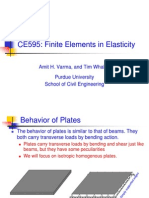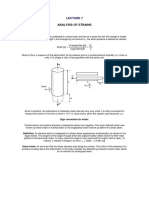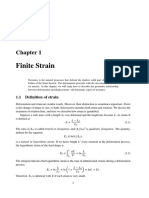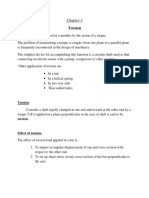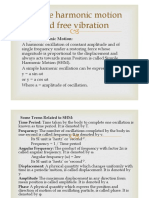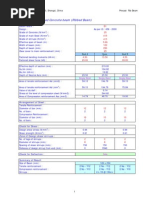0 ratings0% found this document useful (0 votes)
49 viewsDeformation: Deformation-Produced in Response To Stress
Deformation: Deformation-Produced in Response To Stress
Uploaded by
Rizki Ramadani1) Deformation describes the change in shape of rocks in response to stress. There are four main components of deformation: translation, rotation, distortion (changes in shape), and dilation (changes in volume).
2) Relationships between stress and strain are complex, as strain results from stress but the axes do not necessarily correspond. Strain can be homogeneous, where the strain is the same throughout the rock, or heterogeneous.
3) Strain is measured using changes in length, volume, and angles to characterize the deformation. Key terms include strain ellipsoids, principal strain axes, and the distinction between coaxial and non-coaxial strain.
Copyright:
© All Rights Reserved
Available Formats
Download as DOCX, PDF, TXT or read online from Scribd
Deformation: Deformation-Produced in Response To Stress
Deformation: Deformation-Produced in Response To Stress
Uploaded by
Rizki Ramadani0 ratings0% found this document useful (0 votes)
49 views12 pages1) Deformation describes the change in shape of rocks in response to stress. There are four main components of deformation: translation, rotation, distortion (changes in shape), and dilation (changes in volume).
2) Relationships between stress and strain are complex, as strain results from stress but the axes do not necessarily correspond. Strain can be homogeneous, where the strain is the same throughout the rock, or heterogeneous.
3) Strain is measured using changes in length, volume, and angles to characterize the deformation. Key terms include strain ellipsoids, principal strain axes, and the distinction between coaxial and non-coaxial strain.
Original Description:
good
Original Title
Deformation
Copyright
© © All Rights Reserved
Available Formats
DOCX, PDF, TXT or read online from Scribd
Share this document
Did you find this document useful?
Is this content inappropriate?
1) Deformation describes the change in shape of rocks in response to stress. There are four main components of deformation: translation, rotation, distortion (changes in shape), and dilation (changes in volume).
2) Relationships between stress and strain are complex, as strain results from stress but the axes do not necessarily correspond. Strain can be homogeneous, where the strain is the same throughout the rock, or heterogeneous.
3) Strain is measured using changes in length, volume, and angles to characterize the deformation. Key terms include strain ellipsoids, principal strain axes, and the distinction between coaxial and non-coaxial strain.
Copyright:
© All Rights Reserved
Available Formats
Download as DOCX, PDF, TXT or read online from Scribd
Download as docx, pdf, or txt
0 ratings0% found this document useful (0 votes)
49 views12 pagesDeformation: Deformation-Produced in Response To Stress
Deformation: Deformation-Produced in Response To Stress
Uploaded by
Rizki Ramadani1) Deformation describes the change in shape of rocks in response to stress. There are four main components of deformation: translation, rotation, distortion (changes in shape), and dilation (changes in volume).
2) Relationships between stress and strain are complex, as strain results from stress but the axes do not necessarily correspond. Strain can be homogeneous, where the strain is the same throughout the rock, or heterogeneous.
3) Strain is measured using changes in length, volume, and angles to characterize the deformation. Key terms include strain ellipsoids, principal strain axes, and the distinction between coaxial and non-coaxial strain.
Copyright:
© All Rights Reserved
Available Formats
Download as DOCX, PDF, TXT or read online from Scribd
Download as docx, pdf, or txt
You are on page 1of 12
DEFORMATION
Deformation- produced in response to Stress
Depends upon:
Type of stress applied
Rock properties (minerals, discontinuities,
etc)
Temperature
Depth
Time
Deformation= change in position, shape or
volume or rotation as a result of applied stress.
Describes the complete displacement field of a
set of points in a body relative to an external
reference frame.
4 deformation components are:
1. Translation- movement from initial location.
2. Rotation- spin about an axis
3. Distortion- change in shape (Strain)-
describes displacement field of points within the
body; i.e., from an internal reference frame.
4.Dilation- volume change
Strain Axes:
X= maximum direction of extension
(or minimal compressive strain
Y= intermediate strain axis
Z= maximum direction of shortening
(or minimum extension).
Relationships between Stress and Strain:
Since strain results from the actions of stresses,
a geometrical relationship between the two must
exist. Documenting this relationship is difficult at
best. Do not assume the stress axes
1
,
2,
3
correspond with strain axes X, Y and Z.
Knowledge of Undeformed States
Strain analysis requires a knowledge of the
original undeformed state of the material (rare in
nature).
Homogeneous Strain- Situation in which strain
in all points of a rock body is the same
Original straight lines remain straight
Original parallel lines remain parallel
Circles become ellipses;
3-D spheres become ellipsoids
Material Lines- lines that contain
recognizable features (e.g., grains, fossils)
that do not rotate relative to one another
during deformation, although the length of
the lines does change.
2-Dimensional Homogeneous Strain:
two orientations of material lines remain
perpendicular before and after strain,
defining the Strain Ellipse
3-Dimensional Homogeneous Strain:
3 or more material lines remain
perpendicular before and after strain,
defining the Principal Strain Axes
X > Y > Z of the Strain Ellipsoid
Heterogeneous Strain- Strain is different in
various parts of the rock body.
1 or more of homogeneous strain conditions do
not apply
Original straight lines do not remain straight
Original parallel lines do not remain parallel
Circles do not become ellipses;
3-D spheres do not become ellipsoids.
All strains may be expressed in terms of
extensions and rotations so that a knowledge of
e, l or w are sufficient to describe the strain
history for any homogeneous domain.
STRAIN KINEMATICS
Strain Path- Kinematic strain development;
describes a series of incremental strain events
cumulatively resulting in a finite strain state.
Incremental Strain-
Intermediate strain steps
describe separate strain conditions;
usually difficult to ascertain.
Finite Strain-
Measure of the strain from an initial to final state
Represents the sum of the incremental strains.
Coaxial vs. Non Coaxial Strain
Coaxial Strain- No rotation of the incremental
strain axes from an initial to final strain state.
The same Material Lines remain the principal
strain axes throughout deformation
No Rotation of Material Lines (Zero Internal
Vorticity)= Pure Shear
Pure Shear (Irrotational Strain)-
X, Y, Z axes do not rotate during progressive
strain.
Uniform elongation in 1 direction
Uniform contraction in perpendicular direction
Principal strain axes correspond to principle
stress axes throughout deformation
Pure shear is a coaxial strain with no change in
volume (rigid, i.e. unrealistic?, interpretation)
Strain axes are parallel to principal stress
axes:
1
= Z
2
=Y
3
=X
Non-Coaxial Strain (Rotational Strain)-
Axes of strain ellipsoid rotate through time
During incremental strain steps, the principal
strain axes do not remain the same
Principal strain axes (Material Lines) occur
throughout incremental strain events; however,
different principal strain axes occur at each
incremental step.
(Card Deck Analogy)
Simple Shear (Rotational Shear)- Non coaxial
strain in which the distance perpendicular to the
shear plane remains constant (thickness of card
deck remains the same)
All points move parallel to a fixed direction
with an amount of displacement proportional
to a distance from some defined plane (e.g.,
parallel to face of cards)
Strain axes do not remain parallel during
progressive deformation
Axes of strain ellipsoid rotate through time.
X, Y and Z axes rotate during progressive
deformation for a fixed single stress
orientation.
Therefore, strain axes do not remain parallel
during deformation.
Hence, the direction of maximum elongation
is not parallel to the direction of minimum
compressive stress or maximum tensional
stress.
The direction of maximum shortening
(minimum extension) is not parallel to the
direction of minimum tension or maximum
compressive stress.
General Shear- combination of pure shear and
simple shear; common.
MEASURING DEFORMATION
Length Changes
Volume Changes
Angular (Rotational) Changes
1. LENGTH DEFORMATION
Longitudinal Strain (e) = extension
Length Change (e)= Change in Length e=L-
L
o
Original
Length L
o
e (extension) =
(L-L
o
)/ L
o
L
o
=Original Length
L= Final Length
e (Extension) is a dimensionless quantity
Shortening- negative values e<0
Extension- positive values e>0
2. Quadratic Elongation ( )
alternative expression for length changes
or
= (l+e)
2
.
3. Stretch (s) s= ( )
1/2
Quadratic Equation and Stretch values are useful
in describing the lengths of the principal axes of
the strain ellipsoid:
X
2
= l
1
Y
2
= l
2
Z
2
= l
3
X=s
1
Y= s
2
Z= s
3
VOLUME DEFORMATION
Volumetric Strain ( )
Volume Change ( )= (V-V
0
)/V
0
V
0
= Original Volume
V= Final Volume
is a dimensionless quantity
Decrease volume- negative values
Increase volume- positive values
ROTATIONAL DEFORMATION
Angular Strain( ) Rotational Change
Change in angle between 2 initially perpendicular
lines
Shear Strain and Angular Shear are
dimensionless.
Shear Strain ( )= tan .
= angular shear (psi)-
= deflection from an originally right angle
= shear strain (gamma)
- change in angle between 2 lines
Strain in 2 Dimensions- consider a circle of unit
radius (r=1) and a center O that has been
deformed into an ellipse with a major (maximum
elongation) axis (
1
) and a minor (minimum
elongation) axis (
2
). Such an ellipse is called
a strain ellipse. Any point P on an original circle
with coordinates X, Z has moved to a new
position with coordinates X', Z'. Note that has
also changed as a result of elliptical strain to '.
Note also that the length of line O-P has been
changed to O-P'.
Strain in 3 Dimensions: Strain Ellipsoid with axes
X, Y and Z.
Check out the following Webpage for Stress and
Strain
visualization:http://www.geology.sdsu.edu/visual
structure/vss/htm_hlp/index.htm
Return to: Geology 320 Main Page
You might also like
- Theory of Elasticity Lecture Notes - DR V S ReddyDocument59 pagesTheory of Elasticity Lecture Notes - DR V S Reddyvempadareddy94% (16)
- Force Calculation Applications in Pipenet: F Tag F Tag FDocument10 pagesForce Calculation Applications in Pipenet: F Tag F Tag FPasquale CutriNo ratings yet
- Deformation and Strain (: Teaching Sources in Structural Geology, University of LeedsDocument55 pagesDeformation and Strain (: Teaching Sources in Structural Geology, University of LeedsRMNo ratings yet
- Rock MechanicsDocument58 pagesRock MechanicsInvisible NatureNo ratings yet
- 2 Strain IDocument52 pages2 Strain ISEDRAZNADNo ratings yet
- Finite StrainDocument27 pagesFinite StrainRMNo ratings yet
- 1.2 StrainDocument27 pages1.2 StrainRitika SharmaNo ratings yet
- Determining Strike and Dip From Geologic Maps (Revisited)Document23 pagesDetermining Strike and Dip From Geologic Maps (Revisited)www_waadgeoNo ratings yet
- StrainDocument12 pagesStrainmadhuspatitripathyNo ratings yet
- StrianDocument9 pagesStrianIhab OmarNo ratings yet
- Finite Strain TheoryDocument27 pagesFinite Strain TheoryJorgeBarriosMurielNo ratings yet
- Strain MhorDocument28 pagesStrain MhorRMNo ratings yet
- Kinematic Analysis NotesDocument5 pagesKinematic Analysis NotesS Hashim RizviNo ratings yet
- Som-1 R20Document31 pagesSom-1 R20Anand perumallaNo ratings yet
- Elasticity PDFDocument7 pagesElasticity PDFSajal SrivastavaNo ratings yet
- Finite Elements in ElasticityDocument45 pagesFinite Elements in ElasticityRajaram KamathNo ratings yet
- Deformation Stress and Strain NotesDocument19 pagesDeformation Stress and Strain NotesPrasoon ShuklaNo ratings yet
- Analysis of StrainsDocument8 pagesAnalysis of StrainsMechanical ZombieNo ratings yet
- Deformation and StrainDocument16 pagesDeformation and Strainpt.22.132No ratings yet
- Elasticity NotesDocument10 pagesElasticity Notesmrg180102002No ratings yet
- Analysis of StrainsDocument8 pagesAnalysis of StrainsJony Oliver Lazo RamosNo ratings yet
- Physics NotesDocument18 pagesPhysics Notesthavaselvan50% (2)
- Finite Strain and Strain EllipsoideDocument27 pagesFinite Strain and Strain EllipsoideJorgeBarriosMurielNo ratings yet
- Load & Stress Analysis - 2Document107 pagesLoad & Stress Analysis - 2shafqut hussain ShahNo ratings yet
- 01 - PPT - Basics of SeismicsDocument63 pages01 - PPT - Basics of SeismicsRishi RanjanNo ratings yet
- Analysis of StrainsDocument6 pagesAnalysis of Strainsranjith kumarNo ratings yet
- ES654A Lecture 6 Strain IIDocument8 pagesES654A Lecture 6 Strain IIPratik ChouguleNo ratings yet
- SM II 1Document128 pagesSM II 1lokesh.ecb2658No ratings yet
- Strength of MaterialDocument163 pagesStrength of MaterialJackKiaNo ratings yet
- Mechanics of StrucureSubjective NotesDocument22 pagesMechanics of StrucureSubjective NotesShyam Sundar YadavNo ratings yet
- Simple Harmonic Motion and Free VibrationDocument25 pagesSimple Harmonic Motion and Free VibrationSANJAY KUMAR MISHRANo ratings yet
- SOM Unit I PDFDocument104 pagesSOM Unit I PDFbhargaviNo ratings yet
- Term Paper Presentation On: Stress - Strain RelationDocument55 pagesTerm Paper Presentation On: Stress - Strain RelationtaditttiNo ratings yet
- To RsionDocument16 pagesTo Rsionpriodeep chowdhuryNo ratings yet
- Flinn DiagramDocument9 pagesFlinn DiagramPranks9827653878No ratings yet
- ME3112 Help SheetDocument10 pagesME3112 Help SheetPS ChuaNo ratings yet
- Rasmussen K Bifurcation Locally Buckled Members 1997 38 BCKL Loc DistDocument38 pagesRasmussen K Bifurcation Locally Buckled Members 1997 38 BCKL Loc DistRicardo Parra ArangoNo ratings yet
- Basic Equations: 1 Definitions, Conventions and Basic RelationsDocument5 pagesBasic Equations: 1 Definitions, Conventions and Basic RelationsVinícius Martins FreireNo ratings yet
- Stress and StrainDocument17 pagesStress and Strainakshatbhargava100% (1)
- Strength of MaterialDocument21 pagesStrength of MaterialkalirajgurusamyNo ratings yet
- S. Neukirch, G.H.M. Van Der Heijden and J.M.T. Thompson - Writhing Instabilities of Twisted Rods: From Infinite To Finite LengthDocument17 pagesS. Neukirch, G.H.M. Van Der Heijden and J.M.T. Thompson - Writhing Instabilities of Twisted Rods: From Infinite To Finite LengthLokosooNo ratings yet
- Elasticity 2024Document15 pagesElasticity 2024crazyom108ytNo ratings yet
- The Forced Vibration of A Three-Layer, Damped Sandwich Beam With Arbitrary Boundary ConditionsDocument13 pagesThe Forced Vibration of A Three-Layer, Damped Sandwich Beam With Arbitrary Boundary Conditionsngoclinhbk05No ratings yet
- SM IiDocument81 pagesSM Iimaddys58No ratings yet
- Ch02 Strain IncompleteDocument12 pagesCh02 Strain Incompletehhjjrr22331No ratings yet
- Simple Harmonic Motion and Free VibrationDocument25 pagesSimple Harmonic Motion and Free VibrationSANJAY KUMAR MISHRANo ratings yet
- MECH3300 Finite Element Methods: Lecture 1 - Introduction To The FEMDocument15 pagesMECH3300 Finite Element Methods: Lecture 1 - Introduction To The FEMKrishna MyakalaNo ratings yet
- L03 TorsionDocument63 pagesL03 TorsionPedro MartinsNo ratings yet
- MDB Lesson 4 Shear Deformation, Poisson's Ratio, Thermal DeformationDocument15 pagesMDB Lesson 4 Shear Deformation, Poisson's Ratio, Thermal Deformationpoliman2017100% (1)
- UNIT-3 Strength of MaterialDocument127 pagesUNIT-3 Strength of Materialakashtripathi0292No ratings yet
- Shell Elements ABAQUSDocument45 pagesShell Elements ABAQUSSsr Saane71% (7)
- Stress and Strain RelationsDocument12 pagesStress and Strain RelationsnazeemlngNo ratings yet
- PH1P4_Elastic Materials UNIT IDocument39 pagesPH1P4_Elastic Materials UNIT I2223 08 Pawan DuhanNo ratings yet
- Theory of Elastisity, Stability and Dynamics of Structures Common ProblemsFrom EverandTheory of Elastisity, Stability and Dynamics of Structures Common ProblemsNo ratings yet
- Cosmology in (2 + 1) -Dimensions, Cyclic Models, and Deformations of M2,1From EverandCosmology in (2 + 1) -Dimensions, Cyclic Models, and Deformations of M2,1No ratings yet
- Seismic Performance of Moment Connections in Steel Moment Frames With HSS ColumnsDocument12 pagesSeismic Performance of Moment Connections in Steel Moment Frames With HSS ColumnsJair Pereira AbrigoNo ratings yet
- Steel Skin Shear Analysis: Page 4 of 4 Proj. No.: XX - XXX By: JWFDocument1 pageSteel Skin Shear Analysis: Page 4 of 4 Proj. No.: XX - XXX By: JWFHassan Ali SadiqNo ratings yet
- Punching Shear EdgeDocument3 pagesPunching Shear EdgeYHK3001No ratings yet
- Introduction On CreepDocument24 pagesIntroduction On CreepAbdul RahimNo ratings yet
- Impact Test PDFDocument3 pagesImpact Test PDFالشهاب ناروتوNo ratings yet
- Expt 2 (A) - Impact Test On Metal SpecimenDocument5 pagesExpt 2 (A) - Impact Test On Metal Specimenjyoti swaroop repaka100% (2)
- A Simple Way For Estimating Mechanical Properties From Stress-Strain Diagram Using MATLABDocument5 pagesA Simple Way For Estimating Mechanical Properties From Stress-Strain Diagram Using MATLABAsad MaqsoodNo ratings yet
- 3s BuildingDocument17 pages3s BuildingNavindu SwamiNo ratings yet
- Solution: Weight of The Beam, WBDocument38 pagesSolution: Weight of The Beam, WBApril Loureen Dale TalhaNo ratings yet
- Precast Rib Beam DesignDocument1 pagePrecast Rib Beam Designanshutomar7915100% (1)
- Numerical and Experimental Study On Reinforced 3DCP Walls Filled With Light-Weight ConcreteDocument14 pagesNumerical and Experimental Study On Reinforced 3DCP Walls Filled With Light-Weight Concretehamed sadaghianNo ratings yet
- Unconfined Compressive Strength Test Is Usually Performed On - A) Sandy Soils C) Organic Soils B) Silty Soils D) Clayey SoilsDocument1 pageUnconfined Compressive Strength Test Is Usually Performed On - A) Sandy Soils C) Organic Soils B) Silty Soils D) Clayey SoilsCieLo ManGaoNo ratings yet
- Design and Construction of Large Diameter Circular Shafts: T.T. Aye, M.S.Y. Tong, K.H. Yi, E. ArunasorubanDocument14 pagesDesign and Construction of Large Diameter Circular Shafts: T.T. Aye, M.S.Y. Tong, K.H. Yi, E. ArunasorubanAdam FredrikssonNo ratings yet
- PT Amira Mitra Persada KontraktorDocument7 pagesPT Amira Mitra Persada KontraktoramiramitrapersadaNo ratings yet
- Chapter 5 Stresses in BeamsDocument17 pagesChapter 5 Stresses in BeamsSensei EimeyZINGNo ratings yet
- Full SomDocument215 pagesFull SomKarthikeyanNo ratings yet
- Rigid Pavement Design As Per IRC 58 2011 BUC and TDC AnalysisDocument3 pagesRigid Pavement Design As Per IRC 58 2011 BUC and TDC Analysisarvind sharmaNo ratings yet
- Given Data: F'C Fy A1 A2 A2/A1 Pu MX My M D BFDocument5 pagesGiven Data: F'C Fy A1 A2 A2/A1 Pu MX My M D BFINNOVATIVE ENGINEERNo ratings yet
- Some Tips - Q&a For The Foundation Modeling ProceduresDocument11 pagesSome Tips - Q&a For The Foundation Modeling ProceduresgerianoNo ratings yet
- Site Specific Response Spectrum and Time History Analysis of Shear Walled BuildingDocument10 pagesSite Specific Response Spectrum and Time History Analysis of Shear Walled BuildingprateeksuperNo ratings yet
- Tensile Splice ACI 350-06Document4 pagesTensile Splice ACI 350-06YioYinNo ratings yet
- Seismic Analysis of Multistoried RCC Building Due To Mass IrregularityDocument7 pagesSeismic Analysis of Multistoried RCC Building Due To Mass IrregularityAfif AzharNo ratings yet
- Bike Crank 13Document41 pagesBike Crank 13layike alemayehuNo ratings yet
- A Meraghini Chemisky - PA66GF30 Composite - Effect of Relative HumidityDocument9 pagesA Meraghini Chemisky - PA66GF30 Composite - Effect of Relative Humiditydon-donnolaNo ratings yet
- API-579 PresentationDocument60 pagesAPI-579 Presentationndtitc100% (2)
- Chapter 5Document16 pagesChapter 5Usha GautamNo ratings yet
- Pressuremeter TestDocument9 pagesPressuremeter TestASAMENEWNo ratings yet
- Column DetailsDocument1 pageColumn DetailsVinod Masani100% (1)
- Strength of MaterialDocument4 pagesStrength of Materialayansiddiqui7700No ratings yet
















